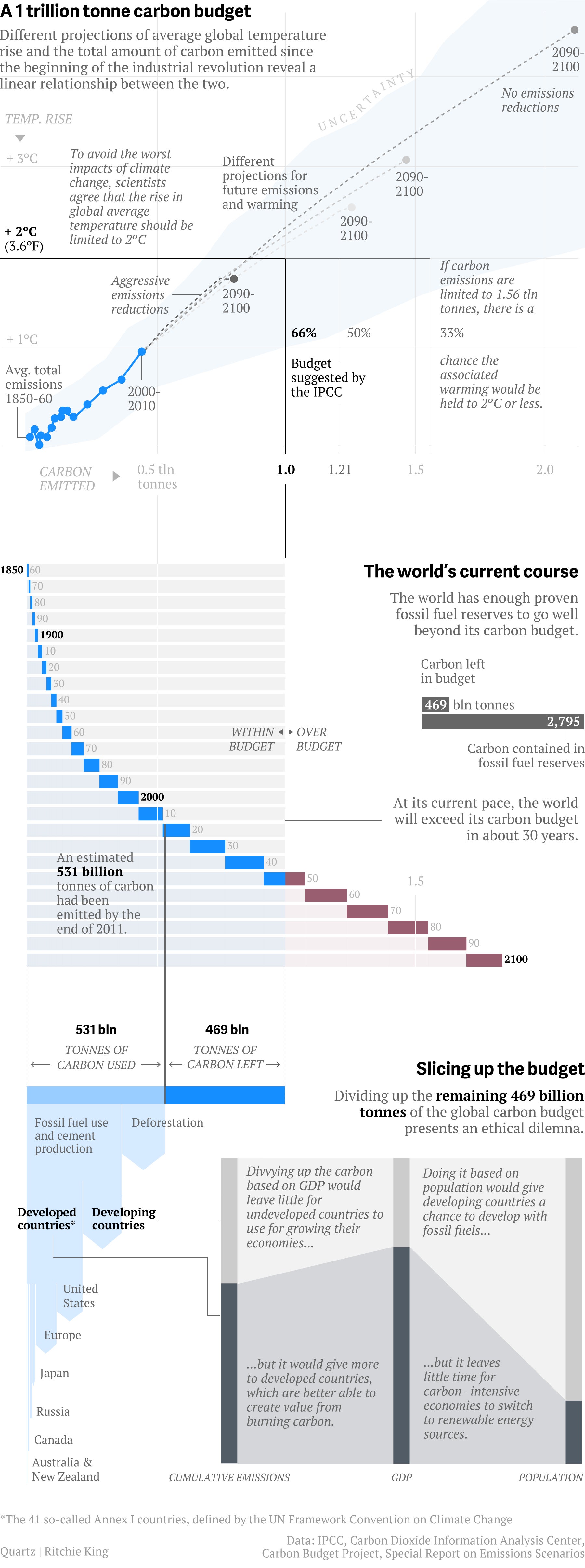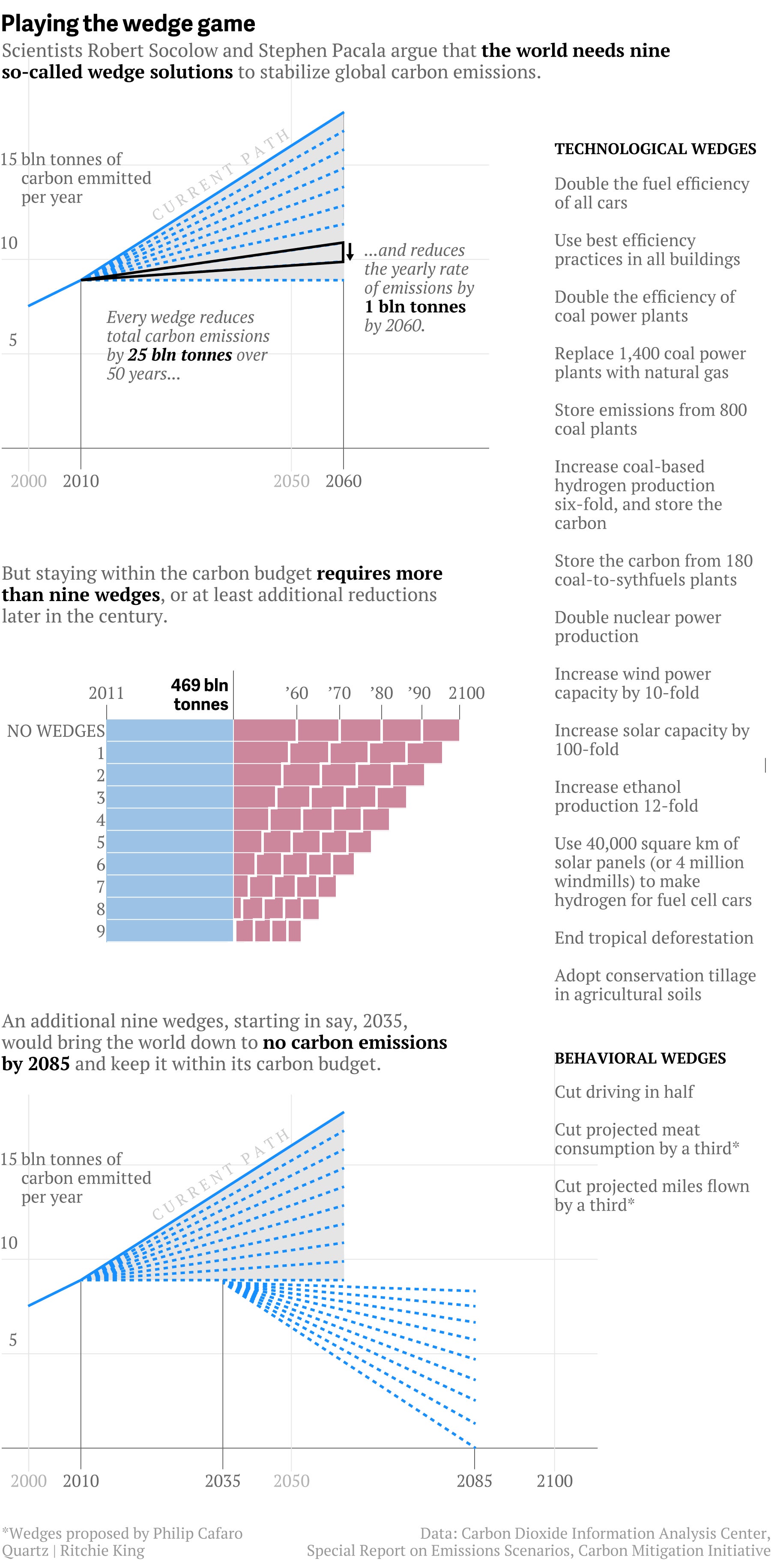How to fix global warming before it’s too late
The fight against climate change has finally hit on a concept that may resonate with world leaders: budgets.


The fight against climate change has finally hit on a concept that may resonate with world leaders: budgets.
Carbon budgeting is catching on just in time for the next round of UN-brokered climate talks, which kick off in Warsaw, Poland, on Nov. 11. It just might provide a framework for the first politically acceptable, scientifically rigorous plan to save the world from the devastating effects of a warming planet.

How to set a carbon budget
In 2008, the UK became the world’s first country to turn the idea of a binding emissions budget into law. The idea has picked up steam since then. In 2012, environmentalist Bill McKibben penned a now-famous piece in Rolling Stone, “Global Warming’s Terrifying New Math,” which helped the idea hit the mainstream.
Just weeks ago, a consensus document written by the world’s top climate scientists and political representatives from 195 countries endorsed a global carbon budget for the first time. That group, the Intergovernmental Panel on Climate Change (IPCC), even gave a figure to shoot for, with some caveats: about one trillion tonnes of carbon.
The idea has its roots in climate science. As shown in the graphic above, scientists have discovered a nearly perfect linear relationship between the sum total of humankind’s historical carbon emissions and the amount of global warming we’re locking ourselves into. Due to carbon dioxide’s century-scale latency in the atmosphere and the slow ramp up of climate change impacts, there’s a finite amount that can ever be safely emitted by humans.
According to the IPCC, if we send no more than one trillion tonnes of carbon into the atmosphere, we’ll have a 66% chance of keeping warming under 2ºC—the generally agreed-upon climatic tipping point, after which all bets are off. Those aren’t the best odds, and those one trillion tonnes don’t include warming from less pervasive, though more powerful, greenhouse gases like methane. In fact, to protect the climate with any real confidence, the world would not only need to stop pouring extra carbon into the atmosphere, but actually start sucking carbon out of it and drive the concentration down from 400 parts per million to 350.
Still, the one trillion-tonne figure has caught on, and it could be a reasonable compromise, or at least a starting point, for a world that’s heavily dependent on fossil fuels.
Staying in budget won’t be easy. We had already used 531 billion tonnes by the end of 2011, more than half of our allotment. As a planet, that leaves us with 469 billion tonnes from 2012 until the end of time. Continuing on at full tilt, we’ll blow through that budget in about 30 years.
A framework for climate talks
On its face, the idea of a global carbon budget is the ideal negotiating tool. There are hard numbers. There are clear consequences for exceeding defined limits. And it’s possible to incorporate the notion that climate negotiations have endorsed since 1992, that all nations share a “common but differentiated responsibility” to avoid further damage to the planet.
But, as with all budget fights, this one has a long list of potential winners and losers, which has slowed progress so far.
The meeting in Warsaw is to discuss how world governments can coordinate their action on climate change. The goals for this particular meeting aren’t very ambitious: The next global treaty won’t be negotiated until 2015 in Paris, and isn’t scheduled to take effect until 2020. In recent days, the goals for that treaty have been lowered, too.
Still, France is already taking steps to avoid another botched opportunity on the scale of the 2009 Copenhagen summit, which let the world’s first binding climate agreement, the Kyoto Protocol, expire without a replacement. They’re listening to US hints that the Paris treaty be limited to an assemblage of voluntary national targets, a nod that any treaty that can’t pass the US House of Representatives would be considered a failure. They’re also keenly aware that a powerful bloc of Small Island States and Least Developed Countries quite literally have their very existence tied to the outcome of these talks.
Powerful developing nations like China and India are widely expected to support the idea that significant financial assistance—at least $100 billion per year—should flow from developed countries in return for the “loss and damages” climate change has already caused. And, on the sidelines, some critics of this process argue that a world geared toward economic growth is fundamentally incompatible with the constraints of living on a finite planet, and the consequences of losing that planet—no matter how remote the odds may be—require taking firm action.
Given the negotiating environment, and the fact that the world is still emerging from recession, hopes for a strong treaty in 2015 are dwindling. The chairperson of the talks herself has balked at the possibility that carbon budgets should form the basis of a binding treaty, calling the act of allocating enforceable national carbon limits politically “difficult.” That’s probably an understatement.
But the idea of a global carbon budget has significant momentum, most of all from the IPCC itself. And the budget need not be allocated by country. Caps could be applied at the global level with individual countries agreeing to coordinated policies designed to keep the world as a whole from busting through the budget’s upper limit. The climate itself is global, after all.
Forget about politics for a second
What remains of the carbon budget—469 billion tonnes—should be treated as an upper limit, a practical goal, if not an ideal one. A better target is probably 250 or less, once you factor in other greenhouse gases and the last two years of emissions. We’re using more than 9 billion tonnes each year, and that number is rising.
Keep in mind, there’s more than enough fossil fuel on the books to blow well past this target. According to the Carbon Tracker Initiative, there’s more than 10 times that amount of carbon (2,795 billion tonnes) in the proven, economically recoverable fossil fuel reserves of the world. More is discovered each year.
What would happen if we burned all that and went 10 times over budget? Climate scientist James Hansen, formerly of NASA, calculated that factoring in likely new discoveries, a continuation of the current course of “business as usual” would result in global warming of 10-12ºC (pdf, pg. 24) within 100 years or so. In that world, agriculture would be impossible, and humans, if they dared to venture outside, would suffer fatal heat stroke within minutes. Many of these changes would be permanent.
So, regardless of politics, now is probably a good time to think about the smartest way to use what fossil fuels we have left.
The way forward
Here are a number of approaches the world could take to stay within its carbon budget:

Practically speaking, it’s doubtful the world will act in concert to implement these solutions. Countries will act individually, so there’s still the problem of divvying up what remains of the carbon budget. The seemingly fairest way to do it—divide up the carbon per person, throughout the world—quickly breaks down when you realize just how fast some countries are burning carbon. For example, the United States, with roughly 5% of the world’s population, produces about 20% of the world’s carbon emissions.
An alternative method—giving the carbon to those who will use it most efficiently—would allocate vast quantities to already rich countries in northern Europe, leaving next to nothing for quickly growing, inefficient countries in the developing world.
So, what to do? A better way forward may actually be counter-intuitive: embrace voluntary national commitments, using a globally agreed-upon carbon budget as a guide.
Nations can be left to figure out the specific policies that best suit them, possibly following the “wedge” framework proposed by Princeton University professors Robert Socolow and Stephen Pacala back in 2004, and shown in the graphic above. Each wedge—for instance, doubling vehicle fuel economy worldwide—avoids 25 billion tonnes of carbon over 50 years, and one billion tonnes per year thereafter. Since 2004, additional wedges have been proposed by Colorado State environmental ethicist Philip Cafaro.
A price on carbon, set sufficiently high, can motivate these wedges all by itself. In fact, according to Cafaro, a carbon price of around $100 per ton “could conceivably provide the eight or more wedges needed to avoid catastrophic global climate change.” Phased in over time and making use of anticipated advances in free-air carbon capture technology, the world could have zero (or even negative!) net carbon emissions within three generations.
Now, it’s just up to world leaders to choose this future over the one we’re currently on track for.